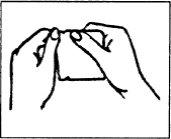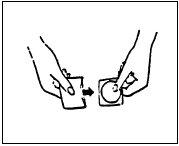

ЕПІНІТРИЛ 10 мг/24 год ТРАНСДЕРМАЛЬНІ ПЛАСТИРІ

Запитайте лікаря про рецепт на ЕПІНІТРИЛ 10 мг/24 год ТРАНСДЕРМАЛЬНІ ПЛАСТИРІ

Інструкція із застосування ЕПІНІТРИЛ 10 мг/24 год ТРАНСДЕРМАЛЬНІ ПЛАСТИРІ
Введення
ОСНОВНІ ВІДОМОСТІ: ІНФОРМАЦІЯ ДЛЯ КОРИСТУВАЧА
Епінітрил 10 мг/24 години трансдермальна пластина
Тринітрат гліцерилу
Перед тим, як почати використовувати цей лікарський засіб, уважно прочитайте весь листок із інструкцією, оскільки він містить важливу інформацію для вас.
- Збережіть цей листок із інструкцією, оскільки вам може знадобитися знову його прочитати.
- Якщо у вас виникли питання, проконсультуйтеся з вашим лікарем або фармацевтом.
- Цей лікарський засіб призначений лише для вас, і не передавайте його іншим людям, навіть якщо вони мають相同ні симптоми, оскільки це може їм нашкодити.
- Якщо ви відчуваєте побічні ефекти, зверніться до вашого лікаря або фармацевта, навіть якщо це побічні ефекти, які не вказані в цьому листку із інструкцією. Див. розділ 4.
Зміст листка із інструкцією:
- Що таке Епінітрил і для чого він використовується
- Що потрібно знати перед тим, як почати використовувати Епінітрил
- Як використовувати Епінітрил
- Можливі побічні ефекти
- Збереження Епінітрилу
- Зміст упаковки та додаткова інформація
1. Що таке ЕПІНІТРИЛ і для чого він використовується
Пластини Епінітрилу містять активну речовину тринітрат гліцерилу, судинорозширюючу речовину, яка використовується при захворюваннях серця і належить до групи лікарських засобів, званих органічними нітратами.
Пластини Епінітрилу наносяться на шкіру, і активна речовина потім постійно проникає через шкіру в організм.
Епінітрил призначений для профілактичного лікування стенокардії, приймається самостійно або в поєднанні з іншим антиангінозним лікуванням.
Стенокардія зазвичай проявляється як біль або тиснення в грудній клітці, хоча може відчуватися в шиї або руці.
Біль з'являється, коли серце не отримує достатньої кількості кисню. Епінітрил не призначений для лікування гострих нападів. Використовуйте вашу таблетку або спрей для під'язичної області для лікування гострих нападів.
Пластини Епінітрилу призначені лише для зовнішнього використання.
2. Що потрібно знати перед тим, як почати використовувати ЕПІНІТРИЛ
Не використовуйтеЕпінітрил:
- якщо ви алергічні (гіперчутливі) до тринітрату гліцерилу, споріднених органічних нітратів або будь-якої іншої складової частини цього лікарського засобу (перелічених у розділі 6);
- якщо у вас є або нещодавно був колапс, пов'язаний з гіпотензією;
- якщо ви відчуваєте біль у голові, нудоту або конвульсії, пов'язані з підвищенням внутрішньочерепного тиску, включаючи ті, які спричинені травмою голови;
- якщо ви страждаєте на серцеву недостатність, викликану обструкцією, наприклад, при наявності звуження аортального або мітрального отвору серця (аортальна або мітральна стеноз) або фіброзного загустіння тонкої оболонки, яка покриває серце (констриктивний перикардит);
- якщо ви приймаєте лікарські засоби для лікування еректильної дисфункції (наприклад, силденафіл або будь-який інший інгібітор фосфодіестерази 5). Нітрати не повинні прийматися пацієнтами, які приймають силденафіл або будь-який інший лікарський засіб, використовуваний для лікування еректильної дисфункції. Пацієнти, які зараз приймають нітрати, не повинні приймати силденафіл або будь-який інший лікарський засіб для лікування еректильної дисфункції. Комбінація нітрату з силденафілом або будь-яким іншим інгібітором фосфодіестерази 5 може спричинити глибоке та раптове зниження артеріального тиску, яке може призвести до втрати свідомості, синкопи або навіть інфаркту міокарда (див. також "Використання інших лікарських засобів");
- якщо ви приймаєте лікарські засоби з ріоцігватом, стимулятором солубльної гуанілатциклази,
- якщо у вас є тяжка гіпотензія (артеріальний тиск нижче 90 мм рт. ст.),
- якщо у вас є тяжка гіповолемія (зниження об'єму крові) через кровотечу або втрату рідини,
- якщо у вас є тяжка анемія,
- якщо у вас є токсичний набряк легенів (токсичний набряк легенів).
Попередження та застереження
Проконсультуйтеся з вашим лікарем або фармацевтом перед тим, як почати використовувати Епінітрил:
- якщо ви припиняєте лікування. Відміна лікування Епінітрилом повинна бути поступовою, заміняючи його на зменшені дози пероральних нітратів тривалої дії;
- якщо вам потрібно пройти магнітно-резонансну томографію, електростимуляцію серця для відновлення нормального серцевого ритму (дефібриляція або кардіоверсія) та перед тепловим лікуванням (діатермія). Відміть пластини Епінітрилу перед тим, як пройти ці процедури;
- якщо у вас є або нещодавно був інфаркт міокарда або якщо раптово з'являються симптоми серцевої недостатності (гостра серцева недостатність) як труднощі з диханням, відчуття великої втоми, набряк ніг. Ваш лікар може призначити лабораторні тести для оцінки вашої серцево-судинної системи;
- якщо у вас є тяжка гіпотензія під час лікування Епінітрилом, потрібно розглянути можливість відміни пластини. У разі колапсу або шоку пластину потрібно відміть;
- якщо ви відчуваєте біль у грудній клітці (гострий напад стенокардії) або якщо ваше серце не перекачує достатньо крові та кисню (нестабільна стенокардія) або у разі інфаркту міокарда, не слід використовувати Епінітрил як негайне лікування;
- якщо у вас є сильний біль у голові або низький артеріальний тиск (гіпотензія) аномального характеру. Це може статися, якщо перша доза надто висока. Рекомендується поступово збільшувати дозу до досягнення оптимального ефекту;
- якщо ви приймаєте інші нітрати або тринітрат гліцерилу сублінгвально, оскільки ваш організм може розвинути резистентність до дії цих речовин після повторної експозиції (крос-резистентність);
- якщо у вас є або нещодавно був низький артеріальний тиск аномального характеру, викликаного тринітратом гліцерилу. У цьому випадку ви можете відчувати низьку частоту серцевих скорочень (брадикардія) та збільшення стенокардії;
- якщо у вас є захворювання зорового нерва (глаукома закритого кута);
- якщо у вас є недостатнє насичення крові киснем (гіпоксемія) через тяжку анемію або захворювання легенів або зниження кровотоку до серця (ішемічна серцева недостатність); пацієнти з цими захворюваннями можуть відчувати порушення вентиляційно-перфузійної взаємозв'язі, яка є показником функції дихання. У цих пацієнтів тринітрат гліцерилу може погіршити це порушення та призвести до зниження насичення крові киснем;
- якщо стенокардія викликана гіпертрофією серця (гіпертрофічна міокардіопатія). Нітрати можуть погіршити цей тип стенокардії;
- якщо у вас є збільшена частота нападів стенокардії під час періодів без пластини. Ваш лікар може бажати повторно оцінити ваше захворювання коронарних артерій та розглянути адаптацію лікування.
- лікування повинно бути припинено, і потрібно проконсультуватися з лікарем, якщо ви відчуваєте феномени чутливості шкіри (свербіж, печія, запалення).
Використання Епінітрилу з іншими лікарськими засобами
Комбінація лікарських засобів для лікування еректильної дисфункції (наприклад, силденафіл або будь-який інший інгібітор фосфодіестерази 5) посилює ефекти зниження артеріального тиску нітратів і, отже, повинна бути уникнена (див. також "Не використовуйте Епінітрил").
Повинно бути уникнено спільне лікування з ріоцігватом, стимулятором солубльної гуанілатциклази, оскільки спільне використання може спричинити гіпотензію (див. також "Не використовуйте Епінітрил")
Спільне лікування з
- лікарськими засобами, які використовуються для зниження артеріального тиску, такими як антагоністи кальцію, інгібітори ЕКА (для лікування серцевої недостатності), бета-блокатори (використовуються для профілактики аритмій), діуретики (збільшують виділення води з організму) та інші антигіпертензивні засоби,
- антidepressивними засобами трициклічної структури (лікарські засоби, які використовуються для лікування депресії),
- нейролептиками (лікарські засоби, які використовуються для профілактики психозу),
- тривкими седативами, а також споживанням алкоголю та в поєднанні з амифостином (лікарський засіб, який використовується для захисту органів під час хіміотерапії та радіотерапії),
- ацетилсаліциловою кислотою (засіб проти запалення, нестероїдний),
може посилити ефекти зниження артеріального тиску Епінітрилу.
Спільне лікування з дігідроерготаміном може зменшити ефект Епінітрилу.
Нестероїдні протизапальні засоби, крім ацетилсаліцилової кислоти, можуть зменшити терапевтичну відповідь на Епінітрил.
Повідомте вашому лікареві або фармацевту, що ви використовуєте, нещодавно використовували або можете використовувати будь-який інший лікарський засіб.
Вагітність, лактація та фертильність
Епінітрил не повинен використовуватися під час вагітності, особливо протягом перших трьох місяців, якщо тільки ваш лікар не призначив його.
Оскільки майже немає інформації про те, чи виділяється тринітрат гліцерилу в грудне молоко, не можна виключити ризик під час лактації. Ваш лікар оцінить, чи потрібно припинити лактацію або лікування Епінітрилом.
Немає даних про вплив Епінітрилу на фертильність у людей.
Якщо ви вагітні або перебуваєте в період лактації, вважаєте, що можете бути вагітною або плануєте вагітність, проконсультуйтеся з вашим лікарем або фармацевтом перед тим, як використовувати цей лікарський засіб.
Водіння транспортних засобів та використання машин
На початку лікування, особливо під час дозової корекції, Епінітрил може впливати на вашу здатність керувати транспортними засобами або використовувати машини, знижуючи вашу реакцію або спричиняючи гіпотензію та головокружіння, а також рідко синкопу після передозування.
Якщо ви відчуваєте ці ефекти, вам слід утримуватися від керування транспортними засобами або використання машин.
3. Як використовувати ЕПІНІТРИЛ
Слідуйте точно інструкціям з застосування цього лікарського засобу, вказаним вашим лікарем. У разі сумнівів проконсультуйтеся з вашим лікарем або фармацевтом.
Рекомендована доза - одна пластина Епінітрилу один раз на добу. Нанесіть пластину на шкіру обережно та тримайте її протягом 12-16 годин. Потім зніміть пластину та тримайте період без пластини протягом 8-12 годин.
Ви повинні змінити пластину Епінітрилу згідно з інструкціями, наданими вашим лікарем. Ваш лікар скаже вам, як довго потрібно тримати пластину на шкірі та тривалість періоду без пластини.
Використання у дітей та підлітків
Епінітрил не повинен використовуватися у дітей та підлітків молодших 18 років.
Як довго потрібно використовувати Епінітрил
Лікування Епінітрилом може тривати кілька років; однак ваш лікар захоче бачити вас періодично, щоб вирішити, чи продовжувати лікування або змінити терапевтичний план.
Як нанести пластину
Нанесіть пластину на чисту та суху шкіру, але не на порізи, плями чи дефекти, а також не на місця, де ви нещодавно нанесли крем, засіб для догляду за шкірою або тальк. Рекомендується наносити пластину Епінітрилу на шкіру грудної клітки (див. Фігуру 1) або верхню зовнішню частину руки, вільну від червоного кольору чи подразнення, та обертати місця нанесення. Якщо це необхідно, можна голити місце нанесення. Слід уникати місць, які утворюють складки чи піддаються тертю під час руху.
Фігура 1

Не наносіть дві пластини підряд на одному й тому ж місці.
Нанесіть одну пластину Епінітрилу на шкіру негайно після видалення з упаковки наступним чином:
(I) Розірвіть упаковку по пунктирній лінії.
Не використовуйте ножиці (див. Фігуру 2).

Фігура 2
(II) Тримайте пластину між великим та вказівним пальцями за етикетку, яку потрібно зняти
(див. Фігуру 3).

Фігура 3
(III) Зніміть захисний покрив з іншої руки
(див. Фігуру 4). Не торкайтеся липкої сторони пластини; інакше вона не приклеїться добре.

Фігура 4
(IV) Нанесіть відкриту частину пластини на шкіру
і зніміть решту захисного покриву.
Тримайте пластину твердо протягом близько 10 секунд на всій її поверхні. Пройдіть пальцями по краях, щоб переконатися, що вони добре приклеїлися.
Вмийте руки перед та після нанесення Епінітрилу.
Для зняття пластини піднімайте край та тягніть пластину повільно, поки вона не зніметься. Після використання пластини зігніть її вдвічі, з липкою стороною всередину, та викиньте у сміття, де до неї не зможуть дістатися діти.
Що робити, якщо пластина знялася?
Якщо ви нанесли Епінітрил правильно, дуже малоймовірно, що пластина зніметься. Однак, якщо пластина знялася, замініть її на нову та потім змініть пластину звичайним чином згідно з вашим початковим графіком.
Якщо ви використали більше Епінітрилу, ніж потрібно
Якщо ви прийняли високі дози тринітрату гліцерилу, ви можете відчувати тяжку гіпотензію та рефлекторну тахікардію або колапс та синкопу, а також порушення гемоглобіну (метгемоглобінемія). Якщо ви нанесли занадто багато пластин одночасно, їх потрібно зняти обережно та промити шкіру під пластинами ретельно, щоб зменшити абсорбцію. У разі гіпотензії або колапсу рекомендується підняти ноги пацієнта або, якщо це необхідно, застосувати компресійний бинт на ноги.
У разі отруєння негайно повідомте вашому лікареві, зверніться до найближчої служби швидкої допомоги або зателефонуйте до служби токсикологічної інформації, телефон 91 562 04 20, вказавши лікарський засіб та кількість, яку ви використали. Покажіть вашому лікареві лікарський засіб або порожню упаковку.
Якщо ви забули змінити пластину
Якщо ви забули змінити пластину вчасно, ви повинні замінити її якнайшвидше та продовжити слідувати вашому початковому графіку для нанесення наступної пластини.
Якщо ви припинили лікування Епінітрилом
При припиненні лікування Епінітрилом ви можете знову відчувати напади стенокардії.
Якщо у вас є будь-які інші питання щодо використання цього лікарського засобу, проконсультуйтеся з вашим лікарем або фармацевтом.
4. Можливі побічні ефекти
Як і всі лікарські засоби, Епінітрил може спричиняти побічні ефекти, хоча не всі люди їх відчувають.
Було повідомлено про наступні побічні ефекти:
Дуже часті побічні ефекти (трапляються у більше ніж 1 пацієнта з 10):
- Нудота.
- Вомітування.
Часті побічні ефекти (трапляються у більше ніж 1 та менше ніж 10 пацієнтів з 100):
- Біль у голові.
Рідкі побічні ефекти (трапляються у більше ніж 1 та менше ніж 10 пацієнтів з 1000):
- Запалення в місці контакту шкіри (контактний дерматит).
- Червоність та подразнення в місці нанесення пластини.
- Свербіж.
- Чуття печіння.
Рідкісні побічні ефекти (трапляються у більше ніж 1 та менше ніж 10 пацієнтів з 10000):
- Тахікардія.
- Ортостатична гіпотензія (зниження артеріального тиску при стоячому положенні), можуть бути описані як транзиторні епізоди головокружіння.
- Червоність шкіри.
- Збільшення частоти серцевих скорочень.
Дуже рідкісні побічні ефекти (трапляються у менше ніж 1 з 10000 пацієнтів):
- Головокружіння.
- Синкопа.
Побічні ефекти невідомої частоти:
- Серцево-судинні розлади (пальпітація).
- Загальне висипання на шкірі (загальне висипання).
Якщо ви відчуваєте побічні ефекти, проконсультуйтеся з вашим лікарем або фармацевтом, навіть якщо це побічні ефекти, які не вказані в цьому листку із інструкцією
Звітність про побічні ефекти
Якщо ви відчуваєте будь-який тип побічного ефекту, проконсультуйтеся з вашим лікарем або фармацевтом, навіть якщо це можливі побічні ефекти, які не вказані в цьому листку із інструкцією. Ви також можете повідомити про них безпосередньо через систему моніторингу лікарських засобів для людини www.notificaRAM.es
Інформуючи про побічні ефекти, ви можете допомогти надати більше інформації про безпеку цього лікарського засобу.
.
5. Збереження ЕПІНІТРИЛУ
Тримайте цей лікарський засіб поза зоною досяжності дітей.
Не зберігайте при температурі вище 25°C. Епінітрил повинен зберігатися в упаковці.
Не використовуйте цей лікарський засіб після закінчення терміну придатності, вказаного на упаковці та упаковці після CAD. Термін придатності - останній день місяця, який вказано.
Лікарські засоби не повинні викидатися у водопровідні труби чи сміття. Віднесіть упаковку та лікарські засоби, які вам не потрібні, до пункту збору фармацевтичних відходів у аптеці. Спитайте вашого фармацевта, як позбутися упаковки та лікарських засобів, які вам не потрібні. Таким чином, ви допоможете захистити навколишнє середовище.
6. Зміст упаковки та додаткова інформація
Склад Епінітрилу
Активна речовина пластин Епінітрилу - тринітрат гліцерилу, і вони доступні в трьох концентраціях: Епінітрил 5 мг/24 години, 10 мг/24 години та 15 мг/24 години.
Епінітрил 10 мг/24 години: містить 31,37 мг активної речовини тринітрату гліцерилу та виділяє близько 10 мг тринітрату гліцерилу на добу (0,4 мг/год); площа виділення пластини становить 12,75 см². Код ідентифікації, надрукований на підтримуючій плівці, - NR10.
Інші складові частини - адгезивна речовина (акрилат-вінілацетатний кополімер), пластифікатор (гідроабієтовий фталат) та ретикулювальний агент (полібутилтитанат), які нанесені разом з активною речовиною на підтримуючу плівку (поліпропіленову плівку з лаком). Адгезивний шар покритий захисним покривом з алюмінію та силікону з обох сторін, який знімається перед використанням.
Відповідний вигляд продукту та вміст упаковки
Епінітріл - це трансдермальні пластирі з липкою частиною ззаду. Кожен пластир індивідуально запакований у захисний конверт.
Розміри упаковки: 15 і 30 пластирів. Можливо, що тільки деякі розміри упаковок будуть реалізовані.
Власник дозволу на продаж та відповідальна особа за виробництво
Власник дозволу на продаж
Viatris Healthcare Limited
Промисловий парк Дамастаун
Мулхуддарт, Дублін 15
Дублін
Ірландія
Відповідальна особа за виробництво
ROTTAPHARM Ltd.
Дамастаун, Промисловий парк, Мулхуддарт
Дублін 15
Ірландія
або
LTS Lohmann Therapie Systeme AG
Логманнштрассе 2
56626 Андернах
Німеччина
Для отримання більшої кількості інформації щодо цього лікарського засобу можна звернутися до місцевого представника власника дозволу на продаж:
Viatris Pharmaceuticals, S.L.
вул. Генерала Арана, 86
28027 - Мадрид
Іспанія
Дата останнього перегляду цього листка:грудень 2022
Детальна та оновлена інформація про цей лікарський засіб доступна на сайті Іспанського агентства лікарських засобів і медичних продуктів (AEMPS) http://www.aemps.gob.es/

Скільки коштує ЕПІНІТРИЛ 10 мг/24 год ТРАНСДЕРМАЛЬНІ ПЛАСТИРІ в Іспанії у 2025 році?
ЕПІНІТРИЛ 10 мг/24 год ТРАНСДЕРМАЛЬНІ ПЛАСТИРІ коштує в середньому 15.42 євро у грудень, 2025 році. Ціна може змінюватися залежно від регіону, аптеки та наявності рецепта. Рекомендуємо перевіряти актуальну вартість у місцевих аптеках або через онлайн-сервіси.
- Країна реєстрації
- Середня ціна в аптеках15.42 EUR
- Діючі речовини
- Потрібен рецептТак
- Виробник
- Інформація є довідковою і не є медичною порадою. Перед прийомом будь-яких препаратів обов'язково проконсультуйтеся з лікарем. Oladoctor не несе відповідальності за медичні рішення, прийняті на основі цього контенту.
- Альтернативи до ЕПІНІТРИЛ 10 мг/24 год ТРАНСДЕРМАЛЬНІ ПЛАСТИРІФорма випуску: ТРАНСДЕРМАЛЬНИЙ ПЛАСТИР, 37,4 мг нітрогліцеринуДіючі речовини: glyceryl trinitrateВиробник: Merus Labs Luxco Ii S.À.R.L.Потрібен рецептФорма випуску: ТРАНСДЕРМАЛЬНИЙ ПЛАСТИР, 18,7 мг нітрогліцеринуДіючі речовини: glyceryl trinitrateВиробник: Merus Labs Luxco Ii S.À.R.L.Потрібен рецептФорма випуску: ТРАНСДЕРМАЛЬНИЙ ПЛАСТИР, 31,37 мгДіючі речовини: glyceryl trinitrateВиробник: Casen Recordati S.L.Потрібен рецепт
Аналоги ЕПІНІТРИЛ 10 мг/24 год ТРАНСДЕРМАЛЬНІ ПЛАСТИРІ в інших країнах
Найкращі аналоги з тією самою діючою речовиною та терапевтичним ефектом.
Аналог ЕПІНІТРИЛ 10 мг/24 год ТРАНСДЕРМАЛЬНІ ПЛАСТИРІ у Польща
Аналог ЕПІНІТРИЛ 10 мг/24 год ТРАНСДЕРМАЛЬНІ ПЛАСТИРІ у Україна
Лікарі онлайн щодо ЕПІНІТРИЛ 10 мг/24 год ТРАНСДЕРМАЛЬНІ ПЛАСТИРІ
Консультація щодо дозування, побічних ефектів, взаємодій, протипоказань та поновлення рецепта на ЕПІНІТРИЛ 10 мг/24 год ТРАНСДЕРМАЛЬНІ ПЛАСТИРІ – за рішенням лікаря та згідно з місцевими правилами.










